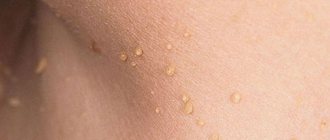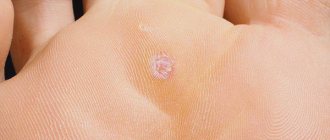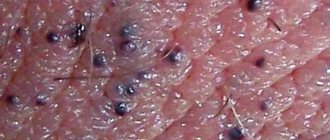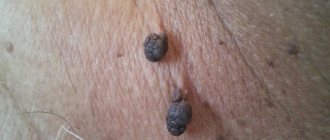Genital warts are one of the most common types of sexually transmitted infections. They are caused by a certain type of human papillomavirus (HPV). It occurs more often in women than in men.
Cost of services in our clinic
| Appointment with a gynecologist with the highest category | 1000 rub. |
| Consultative appointment with a doctor based on test results and ultrasound results | 500 rub. |
| Extended colposcopy | 1500 rub. |
| Amino test for bacterial vaginosis | 300 rub. |
| Medical abortion (all inclusive) | 4500 |
| Make an appointment by phone: 8-800-707-15-60 (toll-free) |
| *The clinic is licensed to remove tumors |
The formations affect the mucous membranes of the genitals. These are small growths, often similar to cauliflower.
Some strains of genital HPV provoke the development of cancer cells. Vaccinations are used to prevent such health problems.
Symptoms
The content of the article
In women, genital warts can grow on the external genitalia, vaginal walls, the area between the external genitalia and the anus, the anal canal, and the cervix. In men, the glans penis, scrotum or anus is affected. These growths sometimes form in the mouth or throat after oral sex with an infected person. Symptoms of genital warts:
- The appearance of small, flesh-colored or gray swelling in the genital area.
- A cluster of several warts located close to each other.
- The occurrence of itching or discomfort in the genital area.
- Bleeding during sexual intercourse.
Genital warts can be so small and flat that they cannot be seen with the naked eye. Sometimes they form large clumps. You should see a doctor if a woman or her partner develops lumps or warts in the genital area.
Routes of infection
HPV transmission occurs primarily through sexual contact.
The possibility of becoming infected during sex is 46–67%.
Homosexuals have a higher incidence of the disease.
Recently, there have been more and more cases of detection of the virus in the amniotic fluid during pregnancy.
Infection of children by parents is possible.
The incubation period of the disease ranges from a month to a year.
Typically, condylomas appear 3 months after sex with an infected partner.
Risk factors
Factors that may increase the risk of infection include:
- unprotected sex with multiple partners;
- suppressed immunity (for example, people living with HIV are at increased risk of acquiring HPV);
- sexual activity at an early age.
Genital complications after illness:
- Cancer. The disease is closely related to infection of the genital organs. Certain types of HPV are also associated with cancers of the anus, penis, mouth and throat. Human papillomavirus does not always lead to cancer, but women should have regular Pap smears, especially if they are at high risk of contracting HPV.
- Problems during pregnancy. The formations may enlarge, making it difficult to urinate. Growths on the vaginal wall reduce the ability of vaginal tissue to stretch during childbirth. Large warts on the genitals or vagina bleed during labor. The mother often transmits the virus to the child, and the baby develops warts, which are especially dangerous in the throat. In this case, a thorough examination and removal of growths is required so that the child can breathe freely.
When should warts in the groin in men be removed?
Warts caused by the papilloma virus should be removed in all cases. The fact is that growths on the skin of a viral nature do not tend to disappear on their own. In addition, if nothing is done, such warts multiply uncontrollably and in a few days can spread throughout the perineum, groin areas and genitals. Skin formations in the groin of a different nature are treated differently. Manifestations of sexually transmitted diseases are eliminated with general medications, for example, tablets and injections. Benign soft fibroids can be left alone if they do not particularly interfere or cause pain. Cancers are treated according to all the principles of oncology.
Rice. 2. Multiple warts in the groin
Prevention
To avoid the development of diseases associated with HPV, it is recommended:
- Use condoms during sexual intercourse.
This significantly reduces the risk of contracting genital warts. - Get vaccinated.
The drug Gardasil protects against four strains of HPV that cause cancer and is used to prevent genital warts. Another vaccine, Cervarix, protects against cervical cancer but not genital warts.
Routine HPV vaccination is recommended for girls and boys aged 11 and 12 years. If vaccinations were not given in childhood, it is recommended that girls and women under 26 years of age, and boys and men under 21 years of age, receive the vaccine.
The drugs are effective if given before they become sexually active. Research has shown that people under the age of 21 and from 21 to 30 years of age who have received the HPV vaccine are 50% protected from infection.
Side effects from vaccines are minor and include soreness at the injection site (shoulder), headaches, low fever, or flu-like symptoms. Sometimes dizziness or fainting occurs after the injection, especially in teenagers.
Outpatient treatment of warts on the genitals
The only effective way to combat genital warts, recognized throughout the world, is to remove them.
There are several methods that can help you get rid of unpleasant tumors in a matter of minutes:
- Laser therapy procedure. It is performed under local anesthesia using a colposcope, which makes it easier to view the intervention area. Laser therapy is very effective and leaves no possibility of relapse. For numerous condylomas, the procedure is repeated every other week.
- Cryotherapy is the freezing of lesions with liquid nitrogen. Used at weekly intervals. Hyperpigmentation or scarring develops after cryotherapy. The effectiveness of treatment depends on the experience of the doctor.
- Trichloroacetic acid. This is a strong caustic substance that causes tissue necrosis as soon as the composition is applied to the affected areas. This method of combating condylomas is effective with small changes, and its effectiveness is estimated at 51-81%. Relapses occur in 36% of patients. Side effects: Excessive use of the drug leaves deep wounds and scars.
- Surgical methods. The procedure is performed under local or general anesthesia. The highest level of cure is provided by curettage and electrosurgery methods. Condylomas after such treatment recur in less than 19% of cases.
- Photodynamic therapy - 5-aminolevulinic acid. The method can be used alone or in combination with laser therapy, cryotherapy or curettage. The advantage is a low percentage of side effects and a high percentage of successful procedures.
Cryotherapy
Laser therapy
Photodynamic therapy
PAP tests
It is important for women to undergo regular pelvic examinations and undergo a vaginal cytology smear (Pap smear). These studies contribute to the timely detection of changes in the vagina and cervix caused by genital warts or early signs of cervical cancer. A smear is taken during a gynecological examination of a special one from the outer and inner surface of the cervix. The procedure is painless and takes 5-10 seconds. The cells are examined under a microscope.
Buschke-Levenshtein condylomas
They are also called giant condylomas.
This form of the disease is a precancerous condition.
Degeneration into a malignant tumor occurs frequently!
Externally, Buschke-Levenshtein condyloma is similar to manifestations of skin cancer.
An experienced specialist will help you distinguish one from the other.
The usual location of giant condylomas is in the intimate areas.
In men, this can be the head of the penis, the foreskin.
In women, the labia are most often affected.
- 1. Giant condyloma forms many folds and looks like cauliflower.
- 2. Bacteria accumulate in these folds.
- 3. The consequence is the appearance of an unpleasant odor.
- 4. Infection and inflammation may develop.
During the examination, an increase in the nearest lymph nodes is recorded.
The growths can be localized in the lower abdomen, on the buttocks.
In difficult situations, they rise to the navel, chest and armpits.
Medicines for the treatment of genital warts
Preparations that are applied to the skin:
- Imiquimod.
This cream enhances the immune system's ability to fight genital warts. Sexual contact should be avoided while the cream is on the skin. This weakens the effect of condoms and the diaphragm and causes skin irritation on your partner. Side effects include skin redness, blisters, body pain, cough, rash and fatigue. - Podophyllin and Podofilox
. Podophyllin is a plant-based resin that destroys the tissue of warts on the genitals. When using Podofilox, you need to know the precautions to avoid causing irritation. This drug is not recommended for use during pregnancy. Side effects: mild skin irritation, itching. - Trichloroacetic acid.
This remedy burns genital warts and is used to remove internal warts. Side effects include mild skin irritation, ulcers or itching. - Synecatechin (Veregen).
The cream is used to treat external genital warts and warts in or around the anal canal. Side effects include skin redness, itching or burning.
You cannot self-medicate so as not to provoke serious complications.
Ways to remove warts in the groin:
- Laser removal is the most popular and highly effective method, which has virtually no contraindications or complications. The wart is evaporated layer by layer with a laser beam. After the session, a barely noticeable mark remains at the site of removal of the skin formation.
- Medical removal. It involves the use of cauterizing liquids. It is better to carry out the procedure of cauterization of warts under the supervision of a doctor. If used independently, they can cause a chemical burn to the skin in the groin area.
- Cryodestruction. Freezing a wart with liquid nitrogen. After treatment, the wart turns into a blister filled with bloody fluid. Healing occurs as with a normal thermal burn. The method has a number of complications, such as burns of surrounding tissues followed by inflammation. The effectiveness of this method is very low.
- Electrotherapy. Removal of warts using high-frequency electric current. There is a risk of burns to surrounding healthy tissues; the effectiveness is low.
- Radio wave operation. The wart is cut off in layers using a radio wave knife. It is not always possible to remove the “roots” of the wart deeply enough, so the risk of recurrence is very high.
- Surgery. Classic removal with a scalpel. Use as a last resort. After the operation, a recovery period is required; a scar is possible at the incision site.
Rice. 6. Condilin is suitable for removing warts in the groin
It should be borne in mind that removing a wart in a man’s groin solves only a cosmetic problem and cannot get rid of the virus. Therefore, whatever method is chosen, it is simultaneously necessary to strengthen the immune system and fight the virus.
With constant monitoring and following recommendations, relapses of the disease can be avoided.
Why do genital warts recur?
Even if treatment is carried out on time, it does not guarantee against relapse.
The virus can become inactive, but remain in the body.
The reappearance of growths often occurs due to a decrease in protective mechanisms.
Decreased immunity causes the process to spread to intimate places.
When infected with the immunodeficiency virus, genital warts grow faster.
With this disease, giant colonies may appear.
Treatment of patients with HIV requires special experience from the doctor, usually it is surgical.
At the second stage, liquid nitrogen removal technology is used.









